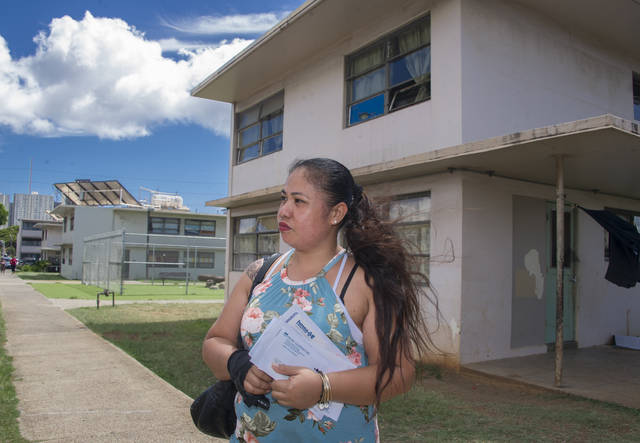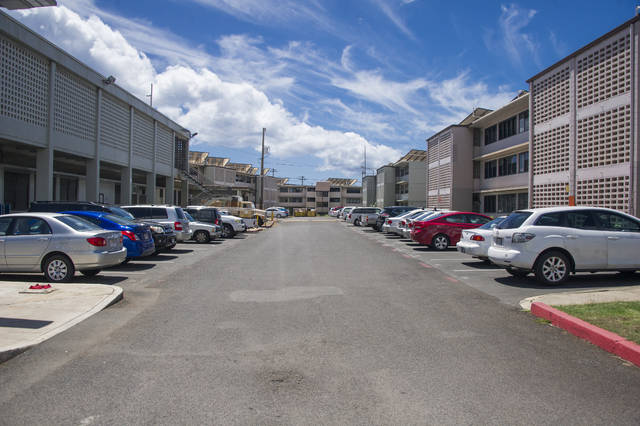Ten years and $1 billion.
That’s what it likely will take to replace the state’s aging Mayor Wright Homes low-income public housing complex in Kalihi with seven times as many rental apartments in a new high-rise community for residents earning a broad range of incomes.
The construction timetable and cost estimate are in a draft environmental impact statement published earlier this month by the Hawaii Public Housing Authority, a state agency that selected Texas- based developer Hunt Cos. in 2014 to replace Mayor Wright’s 364 homes with 2,500 new apartments.
The environmental report adds details to an earlier outline of how the 15-acre Mayor Wright property dotted with two- and three-story apartment buildings should be remade through the public-private partnership.
Under the latest conceptual plan, a company called MWH Partners LLC led by Hunt would construct four towers as high as 380 feet rising out of broader midrise base buildings containing some homes and retail tenants possibly including a grocery store. A central park, a community center, rooftop recreation decks and an early childhood public school also are envisioned.
Hakim Ouansafi, HPHA executive director, said the project will catalyze public and private investment to create a vibrant mixed-income community that will revolutionize public housing as we know it.
“The state of Hawaii is in the middle of an affordable- housing crisis,” he said. “This redevelopment will not only further the governor’s goal to provide 10,000 new affordable rental units by 2020, but will also transform an out-of-date housing project into an attractive and efficient mixed-income, mixed-use community for all Hawaii residents to enjoy.”
Ouansafi said building of the first phase will start by 2019 after further design work, permitting, development agreement negotiations and financing arrangements that could include public and private sources. The plan calls for five phases in all with each taking two years to build.
All incomes welcome
Monthly rents, which are tied to household incomes, range from $127 to $1,877 and wouldn’t change for tenants after rebuilding unless their incomes change.
The initial phase is expected to displace 90 to 100 households until the first tower is finished, and HPHA recommends providing those affected with relocation assistance and benefits. After the initial phase is done, new homes would be available to all other tenants as their units are demolished in subsequent phases.
Mairin Welle, who has lived at Mayor Wright for two years, isn’t too keen about living in a tower, but she said new homes would be good because some apartments are in bad shape. “They need to fix it,” she said.
One young woman, who was born and raised at Mayor Wright but didn’t want her name published to avoid any repercussions to her family for being critical, said the state in the past started various small improvement projects that weren’t finished. So she’s skeptical that a $1 billion plan will be realized. “If it happens, I’ll be excited,” she said.
Redeveloping Mayor Wright is cast as an example of transit-oriented development that delivers more low-income housing with better amenities while also integrating households with incomes from low to moderate and above.
About two-thirds of the 2,500 homes, or 1,650 homes, would be reserved for low- and moderate-income residents. The other 850 homes would be rented at market rates to offset development and maintenance costs.
Gavin Thornton of the Hawaii Appleseed Center for Law and Economic Justice said the mixed-income housing model is great.
“Concentrated poverty is a bad idea,” he said.
Thornton added that Mayor Wright, which was built 64 years ago, needs to be replaced. “The place is falling apart,” he said. “There’s a lot of potential for that property, and it definitely needs to be used to its fullest potential.”
The complex named after Honolulu’s fifth mayor, George Frederick Wright, opened in 1953. In later decades, though, the gated community degraded with substandard upkeep, crime and violence.
260- to 380-foot towers
Over the last six years since Ouansafi became HPHA’s leader, about $1 million has been invested in basic upgrades that improved safety, living conditions and community pride.
Changes included replacing broken mailboxes, illuminating dark areas, installing security cameras, erecting sturdier fencing and beefing up security patrols. Ouansafi ordered the changes after living at Mayor Wright for four months under an alias to understand the quality of life for residents there.
Those improvements helped raise occupancy to 99 percent from 60 percent. But wholesale change is needed, and the property within a quarter-mile of a planned city rail station offered an opportunity to provide more affordable homes to reduce a waitlist of 14,000 Hawaii families seeking public housing.
HPHA’s report said that to supply 2,500 new homes for mixed-income tenants, extra building density and height are necessary.
Towers, which would be oriented with their broad sides perpendicular to the mountains and ocean to preserve mauka-makai views, would range in height from 260 to 380 feet, or roughly 26 to 38 stories, to produce a varied skyline. Midrise buildings serving as tower bases would range from four to nine stories. Density would equate to about 4.8 million square feet of floor space.
Though city zoning for the site allows only up to 1.2 million square feet of floor space and 150-foot buildings, the higher levels planned are allowed under a city ordinance adopted last year for public housing.
“This density and height is required in order to provide the range and mix of affordable, workforce, and market-rate rental housing in an efficient and cost-effective manner to house as many residents as possible,” the report said.
HPHA projects that up to 577 construction jobs would be created each year while the project is built, and that afterward there would be 380 new jobs at Mayor Wright in retail, office and service positions.
Revenue generated for the state and city during construction is projected to be $63.6 million and $3.4 million, respectively.
HPHA said the state Department of Education could assess a roughly $20 million school impact fee, though initial discussions have explored providing space for a prekindergarten or up to first-grade elementary school at Mayor Wright.
If construction proceeds, the first phase would involve tearing down 90 to 100 homes closest to the corner of North King and Liliha streets and replacing them with 650 new homes mainly in one tower.
“Mayor Wright Homes will be transformed into a revitalized community and build on the great progress and improvements that the HPHA achieved over the last five years, with comfortable new units and a mix of commercial and family-friendly gathering spaces that will be a desirable place to live,” said Hunt Senior Vice President Thomas Lee.




